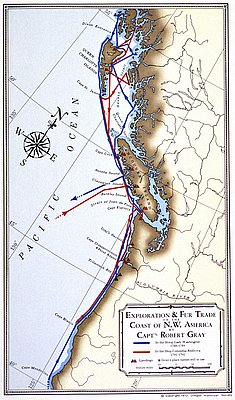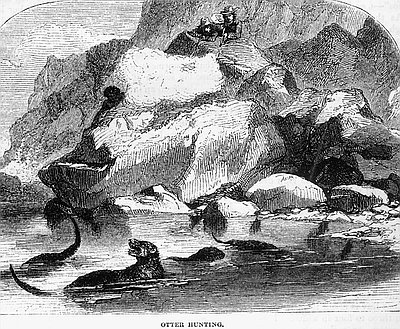- Catalog No. —
- CN 022253
- Date —
- October 1856
- Era —
- 1846-1880 (Treaties, Civil War, and Immigration)
- Themes —
- Environment and Natural Resources, Trade, Business, Industry, and the Economy
- Credits —
- Oregon Folklife Program
- Regions —
- Coast
- Author —
- William Wells, Harper's New Monthly Magazine
Otter Hunting
The illustration above shows a party of otter hunters near Coos Bay in 1856. It was common to shoot otter from the shore as depicted here, though small boats were also used to spear, shoot, net, and snare the fur-bearing marine mammals. The fur trade was no longer a dominant part of the region’s economy by the mid-nineteenth century, but Indians and white settlers on the Oregon Coast continued to supplement their income by selling furs to Chinese merchants in San Francisco.
Members of the weasel family, sea otter are intelligent animals known for their playfulness and curiosity. They subsist primarily off of fish and bottom-dwelling invertebrates like sea urchins, crabs, and clams. Scientists consider them keystone species since they exert important influences on the structure and composition of inshore marine ecosystems.
Unlike most marine mammals, sea otter do not rely on blubber to keep them warm in the cold Pacific. Instead, they depend on their exceptionally dense fur, which, when properly groomed and free from contaminants like oil, is waterproof. It is this rich, luxurious pelt that drew traders from around the world to the Northwest Coast during the late eighteenth and early nineteenth centuries.
Sea otter once ranged from Baja California up through Alaska and across into the waters off Siberia and northern Japan. Bones in middens excavated on the Oregon Coast indicate that sea otter were once abundant here. Heavy hunting pressure nearly wiped the species out, however, and by the 1920s only remnant populations remained in Siberia, Alaska, and California. The last known Oregon sea otter was shot in 1906 at Otter Rock.
Although attempts by state and federal wildlife agencies in the early 1970s to relocate Alaskan otter to Oregon failed, a handful of sea otter sightings have been documented in recent years, probably strays from a small population of relocated Alaskan sea otter on Washington’s Olympic Peninsula.
Further Reading:
Kenyon, Karl W. The Sea Otter in the Eastern Pacific. Washington, D.C., 1970.
Scofield, John. Hail, Columbia!: Robert Gray, John Kendrick, and the Pacific Fur Trade. Portland, Oreg., 1992.
Written by Cain Allen, © Oregon Historical Society, 2003.
Related Historical Records
-
Exploration & Fur Trade by Robert Gray
The Oregon Historical Society produced this map in 1972 to illustrate the voyages of Captain Robert Gray to the Northwest Coast in the late eighteenth century. Captain Robert …

-
Otter Hunting
The illustration above shows a party of otter hunters near Coos Bay in 1856. It was common to shoot otter from the shore as depicted here, though small …

